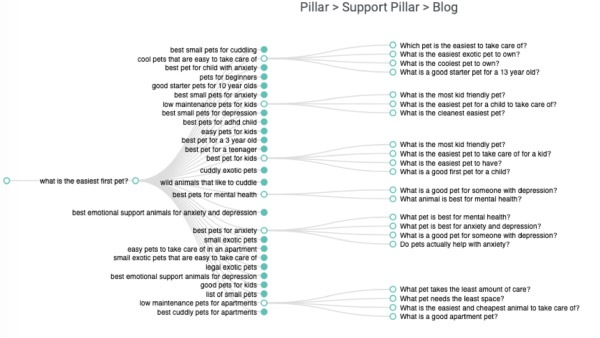How Do You Identify a Topic Cluster?
March 25, 2022 •Chris Gabryszewski

Out of the over 1.8 billion websites floating around cyberspace, a whopping 90% get zero traffic. With 88% of shoppers beginning their buying process online, being invisible on the internet lets your competitors get their business before you even have a chance.

So, what are nearly all websites doing wrong to get sucked into the void, and how can you be sure to escape it? We’ve found success for our clients by implementing an SEO pillar strategy with a surrounding topic cluster.
This article will show you how a topic cluster works and give you best practices for choosing your topic. For an even more detailed guide, check out our post on topic cluster examples.
What Is a Topic Cluster?
A topic cluster is a group of web content that is connected by two key components: a shared topic and backlinks to the topic cluster pillar page. The goal of a topic cluster is to provide quality content that answers the questions that your customers are searching for. Having backlinks to your central pieces boosts your search engine rankings.
Let’s break it down a little further. Our DemandJump pillar strategies break topic clusters into three levels.
- Pillar Page: A piece of long-form content (about 3,000 words containing 18 keywords and questions). Your pillar page introduces many of the topics and questions that your cluster will cover. Even though there is a lot to cover, pillar pages should still satisfy commonly asked questions.
- Sub-pillars: Slightly shorter pieces of content (about 1,750 words containing 12-15 keywords and questions) that link back to the pillar. Your sub-pillars will each hone in on a topic mentioned in the pillar page.
- Supporting Blogs: Short pieces of content (about 750 words containing 8 keywords and questions) that link back to both the pillar and sub-pillar. Your supporting blogs go into the most detail about an individual subject.
The key to an effective, high-ranking topic cluster is quantity and quality. Customers approach their problems from a variety of angles. Make sure your content speaks to as many of those angles as possible and gives relevant and actionable advice.
How Do I Create a Keyword Cluster?
Now that you know how a topic cluster fits into your SEO strategy, let’s go over how to choose the best topic by using a keyword cluster. Search engines reward content that includes high-value keywords that are relevant to your topic. With an advanced keyword grouping tool like DemandJump, you can find keywords that are high-value and work together to form your topic cluster.
Let’s take a step-by-step look at how to identify and implement a topic cluster using Liz’s Pet Supply Store as an example:
- Determine what topic you want to rank for. Liz wants her pet supply store that sources animals from local rescues to be the go-to spot when people are adopting their next pet (and buying all the necessary and fun supplies for their new family member). Since it’s such a broad topic, she needs to narrow it down to build an effective strategy around it.
- Discover high-value keywords and the most-searched questions about that topic. Using DemandJump, Liz discovers that the most-searched terms for prospective pet customers are: “What is the easiest pet to take care of?” “What is the most kid-friendly pet?” and “What is the easiest first pet?”
- Select a keyword/question to use that connects with your strategy. Liz chooses “What is the easiest first pet?” because it aligns with her strategic goals the most.
- Build a topic cluster around your main topic by incorporating related keywords and questions. With her topic cluster identified, Liz uses DemandJump’s topic cluster generator to find questions related to “What is the easiest first pet?”
- Organize your topic cluster into a pillar strategy. Thanks to the topic cluster generator, this part is easy. See how our tool breaks it down:

Then, choose several sub-pillars each with a few supporting blogs to make sure you are supporting your strategy. Liz decides to go with:
- “What is the easiest first pet?” (Pillar)
- “Cool pets that are easy to take care of” (Sub-pillar)
- “What is the easiest exotic pet to own?” (Supporting Blog)
- “What is the coolest pet to own?” (Supporting Blog)
- “What is a good starter pet for a 13 year old?” (Supporting Blog)
- “Best pets for kids” (Sub-pillar)
- “What is the most kid-friendly pet?” (Supporting Blog)
- “What is the easiest pet to take care of for a kid?” (Supporting Blog)
- “What is a good first pet for a child?” (Supporting Blog)
- “Low maintenance pets for apartments” (Sub-pillar)
- “What pet needs the least space?” (Supporting Blog)
- “What is the easiest and cheapest pet to take care of?” (Supporting Blog)
- “What is a good apartment pet?” (Supporting Blog)
How Do You Write a Topic Cluster?
Quality is essential to having an effective topic cluster that gets your website to Google’s coveted page one. Using the right keywords and linking strategy are necessary components, but search engine algorithms also place significant value on how much your content is actually helping people. This is often determined by the amount of time your readers spend on your piece. Generally speaking, a short time spent on an article means that the reader didn’t engage and clicked off the page.
But how do you achieve a high level of engagement with your content?
Content Writing Made Easy with DemandJump
DemandJump does more than just demystify SEO by finding and grouping the highest-value keywords that support your strategic goals. With our content briefs, we also organize those keywords and questions into outlines for your pillar, sub-pillar, or supporting blog post.
The industry average for time readers spend on an article is 54 seconds. Our insights help writers create content that keeps readers engaged. In fact, our readers are typically spending at least five minutes on our pages.
Find out what that difference can do for your business, and try DemandJump today for free!
Featured Articles
Categories
- Attribution Tracking (13)
- Channel Optimization (11)
- Consumer Insights (68)
- Content Marketing (251)
- Data Science (8)
- Digital Marketing (6)
- Digital Transformation (26)
- Enterprise (10)
- Lead Generation (14)
- Market Intelligence (8)
- Marketing Analytics (39)
- Marketing Attribution (57)
- Marketing Management (153)
- Marketing Operations (86)
- Organic Search (222)
- Paid Search (52)
- Pillar-Based Marketing (63)
- Programmatic Advertising (9)
- SaaS Content (14)
- SaaS Marketing (29)
- Search Marketing (111)
- SEO Keyword Research (28)
- SEO Pillar (18)
- SEO Strategy (46)
- SMB (5)
- Website Content (12)


